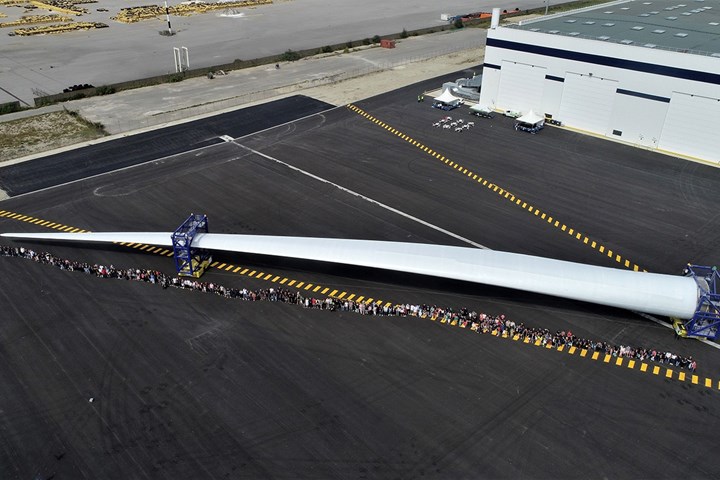ZEBRA project launched to develop first 100% recyclable wind turbine blades
A cross-sector consortium has been brought together to demonstrate the relevance of thermoplastic wind turbine blades, with an eco-design approach to facilitate recycling.

Photo Credit: LM Wind Power
In Sept. 2021, the ZEBRA (Zero wastE Blade ReseArch) project, driven by French research center IRT Jules Verne (Bouguenais), brought together industrial companies and technical centers to demonstrate on a full scale the technical, economic and environmental relevance of thermoplastic wind turbine blades, with an eco-design approach to facilitate recycling. The project has been launched for a period of 42 months with a budget of €18.5 million ($21.8 million).
To accelerate the wind power industry’s transition to a circular economy for wind turbine blades, the ZEBRA project reportedly establishes a strategic, cross-sector consortium that represents the full value chain: from development of materials, to blade manufacturing, to wind turbine operation and decommissioning, and finally recycling of the decommissioned blade material.
-
Arkema (Cologne, Germany), which has developed Elium, a thermoplastic resin, well known for its recyclable properties by depolymerization or dissolution. This resin will be used in the ZEBRA project.
-
The project will benefit from R&D center CANOE’s (Pessac, France) expertise on polymer formulation, carbon fiber development and polymer recycling. CANOE has recently developed an innovative recycling process of fiber-reinforced acrylic composite material by dissolution method providing what is said to be a high added-value recovery of both separate recycled methyl methacrylate monomer and recycled fiber.
-
Engie SA (La Défense, France) is a wind farm operator, with 8.5 gigawatts (GW) under management, with more than 2.6 GW of installed capacities. Its purpose is to act to accelerate the transition towards a carbon-neutral economy, in particular through the sustainable development of renewable technologies.
-
LM Wind Power (Kolding, Denmark) designs and manufactures wind turbine blades, with more than 228,000 blades produced since 1978. The Cherbourg factory associated with the ZEBRA project has produced what is said to be the largest blade ever manufactured at 107 meters in length.
-
Owens Corning (Toledo, Ohio, U.S.) specializes in the field of glass fiber and composite elements and is the inventor of patented high-modulus glass technology.
-
Suez (Paris, France), which helps cities and industries to intelligently and sustainably manage their resources, brings its expertise in the eco-design of the materials used and in the best recycling techniques
Within the ZEBRA project, LM Wind Power will design the product, process and manufacture two prototype blades using Arkema’s Elium resin, in order to test and validate the behavior of the composite material and its feasibility for industrial production. In parallel, the ZEBRA project partners will focus on developing and optimizing the manufacturing process by using automation, to reduce energy consumption and waste from production. Project partners will then explore methods to recycle the materials used in the prototype blades into new products. Finally, a life cycle analysis (LCA) will assess the environmental and economic viability of further using the thermoplastic material in future wind turbine blades.
Related Content
-
The making of carbon fiber
A look at the process by which precursor becomes carbon fiber through a careful (and mostly proprietary) manipulation of temperature and tension.
-
Novel dry tape for liquid molded composites
MTorres seeks to enable next-gen aircraft and open new markets for composites with low-cost, high-permeability tapes and versatile, high-speed production lines.
-
Thermoplastic composites welding advances for more sustainable airframes
Multiple demonstrators help various welding technologies approach TRL 6 in the quest for lighter weight, lower cost.













